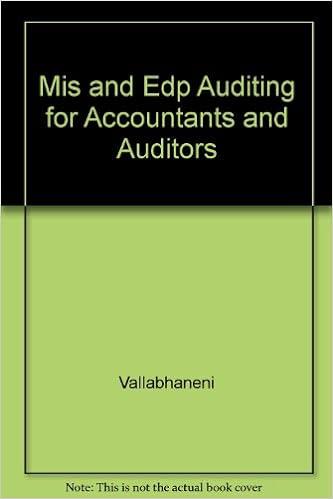Answered step by step
Verified Expert Solution
Question
1 Approved Answer
Required information Problem 6-2AA (Algo) Periodic: Alternative cost flows LO P3 [The following information applies to the questions displayed below.] Warnerwoods Company uses a periodic



Required information Problem 6-2AA (Algo) Periodic: Alternative cost flows LO P3 [The following information applies to the questions displayed below.] Warnerwoods Company uses a periodic inventory system. It entered into the following purchases and sales transactions for March. For specific identification, units sold include 50 units from beginning inventory, 460 units from the March 5 purchase, 130 units from the March 18 purchase, and 210 units from the March 25 purchase. Problem 6-2AA (Algo) Part 3 3. Compute the cost assigned to ending inventory using (a) FIFO, (b) LIFO, (c) weighted average, and (d) specific dentification. Note: Round your "average cost per unit" to 2 decimal places. a) Periodic FIFO \begin{tabular}{|c|c|c|c|c|c|c|c|c|c|} \hline \multirow[b]{3}{*}{ Beginning inventory } & \multicolumn{3}{|c|}{\begin{tabular}{c} Cost of Goods Available \\ for Sale \end{tabular}} & \multicolumn{3}{|c|}{ Cost of Goods Sold } & \multicolumn{3}{|c|}{ Ending Inventory } \\ \hline & \multirow{2}{*}{\begin{tabular}{r|} \begin{tabular}{c} # of \\ units \end{tabular} \\ 190 \\ \end{tabular}} & \multirow[t]{2}{*}{\begin{tabular}{c} Cost \\ per \\ unit \\ \end{tabular}} & \begin{tabular}{|c|} Cost of \\ Goods \\ Availabl \\ for \\ Sale \\ \end{tabular} & \multirow[t]{2}{*}{\begin{tabular}{c} \begin{tabular}{c} # of \\ units \\ sold \end{tabular} \\ 80 \end{tabular}} & \multirow[t]{2}{*}{\begin{tabular}{l} Cost \\ per \\ unit \end{tabular}} & \begin{tabular}{c} Cost of \\ Goods \\ Sold \end{tabular} & \multirow[t]{2}{*}{\begin{tabular}{|r|} \begin{tabular}{l} # of units \\ in ending \\ inventory \end{tabular} \\ 190 \\ \end{tabular}} & \multirow[t]{2}{*}{\begin{tabular}{l} Cost \\ per \\ unit \\ \end{tabular}} & \begin{tabular}{l} Ending \\ Invento \end{tabular} \\ \hline & & & & & & 0 & & & $ \\ \hline \multicolumn{10}{|l|}{ Purchases: } \\ \hline March 5 & 490 & & 0 & 85 & & 0 & & $0.00 & 0 \\ \hline March 18 & 300 & & 0 & 90 & & 0 & & $0.00 & 0 \\ \hline March 25 & 380 & & 0 & 92 & & 0 & 380 & & 0 \\ \hline Total & 1,360 & & & 347 & & & 570 & & \\ \hline \end{tabular} b) Periodic LIFO \begin{tabular}{|c|c|c|c|c|c|c|c|c|c|} \hline \multicolumn{10}{|l|}{ c) Average Cost } \\ \hline & \multicolumn{3}{|c|}{\begin{tabular}{c} Cost of Goods Available \\ for Sale \end{tabular}} & \multicolumn{3}{|c|}{ Cost of Goods Sold } & \multicolumn{3}{|c|}{ Ending Inventory } \\ \hline & \begin{tabular}{l} \# of \\ units \end{tabular} & \begin{tabular}{c} Average \\ Cost \\ per \\ unit \end{tabular} & \begin{tabular}{c} Cost of \\ Goods \\ Availabl \\ for \\ Sale \end{tabular} & \begin{tabular}{c} \# of \\ units \\ sold \end{tabular} & \begin{tabular}{c} Average \\ Cost \\ per \\ Unit \end{tabular} & \begin{tabular}{c} Cost of \\ Goods \\ Sold \end{tabular} & \begin{tabular}{l} \# of units \\ in ending \\ inventory \end{tabular} & \begin{tabular}{c} Average \\ Cost \\ per \\ unit \end{tabular} & \begin{tabular}{l} Ending \\ Invento \end{tabular} \\ \hline Beginning inventory & 190 & & & & & & & & \\ \hline \multicolumn{10}{|l|}{ Purchases: } \\ \hline March 5 & 490 & & & & & & & & \\ \hline March 18 & 300 & & & & & & & & \\ \hline March 25 & 380 & & & & & & & & \\ \hline Total & 1,360 & & & 86 & & 0 & & & $ \\ \hline \multicolumn{10}{|c|}{ d) Specific Identification } \\ \hline & \multicolumn{3}{|c|}{\begin{tabular}{c} Cost of Goods Available \\ for Sale \end{tabular}} & \multicolumn{3}{|c|}{ Cost of Goods Sold } & \multicolumn{3}{|c|}{ Ending Inventory } \\ \hline & \begin{tabular}{l} \# of \\ units \end{tabular} & \begin{tabular}{l} Cost \\ per \\ unit \end{tabular} & \begin{tabular}{c} Cost of \\ Goods \\ Availabl \\ for \\ Sale \\ \end{tabular} & \begin{tabular}{c} \# of \\ units \\ sold \end{tabular} & \begin{tabular}{l} Cost \\ per \\ unit \end{tabular} & \begin{tabular}{c} Cost of \\ Goods \\ Sold \end{tabular} & \begin{tabular}{l} \# of units \\ in ending \\ inventory \end{tabular} & \begin{tabular}{l} Cost \\ per \\ unit \end{tabular} & \begin{tabular}{l} Ending \\ Invento \end{tabular} \\ \hline Beginning inventory & 190 & & & & & 0 & & & $ \\ \hline \multicolumn{10}{|l|}{ Purchases: } \\ \hline March 5 & 490 & & & & & 0 & & & 0 \\ \hline March 18 & 300 & & & & & 0 & & & 0 \\ \hline March 25 & 380 & & & & & 0 & & & 0 \\ \hline Total & 1,360 & & & 0 & & & 0 & & \\ \hline \end{tabular}
Step by Step Solution
There are 3 Steps involved in it
Step: 1

Get Instant Access to Expert-Tailored Solutions
See step-by-step solutions with expert insights and AI powered tools for academic success
Step: 2

Step: 3

Ace Your Homework with AI
Get the answers you need in no time with our AI-driven, step-by-step assistance
Get Started


